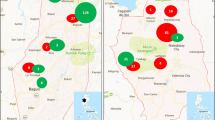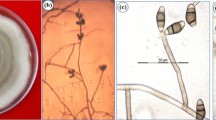Abstract
Potato bacterial wilt caused by Ralstonia solanacearum is one of the most destructive diseases in potato production areas worldwide. One-hundred-six colonies were obtained from a single typical colony recovered from a potato tuber showing internal brown rot symptoms. Colonies’ identity was confirmed as R. solanacearum phylotype II sequevar 1 via PCR. Based on the morphological characterization and the average attenuation index (AI), colonies grouped into typical, intermediate, and atypical forms. However, the small variations in AI make it very difficult to make sure identification and this index cannot be a definitive identification system for R. solanacearum forms. The atypical colonies did not revert to typical or intermediate forms, whereas the both latter ones changed to the three forms with different percentages. For forthcoming experiments, two subcultures of each morphological form were selected. The pathogenicity experiments showed that these subcultures were also grouped into three forms: virulent, intermediate and avirulent. The source of peptone in the agar medium caused significant effects on R. solanacearum colonial morphological characteristics and its pathogenesis. Consequently, it is recommended to use one source of peptone during subculturing and maintaining R. solanacearum forms, as well as studying host-pathogen interaction. The subcultures of R. solanacearum produced a brown diffusible pigment from L-tyrosine on TZC media devoid of ascorbic acid but 1 mM ascorbic acid affected pigmentation. It is suggested that the efficacy of ascorbic acid as a plant-resistance inducer in controlling bacterial wilt disease should be carefully evaluated as it apparently favors R. solanacearum inside the plant tissues.

Similar content being viewed by others
References
Ahmad S, Lee SY, Kong HG, Jo EJ, Choi HK (2016) Genetic determinants for pyomelanin production and its protective effect against oxidative stress in Ralstonia solanacearum. PLoS One 11:1–16
Balabel NM, Eweda WE, Mostafa MI, Farag NS (2005) Some epidemiological aspects of Ralstonia solanacearum. Egypt J Agric Res 83:1547–1564
Boucher CA, Van Gijsegem F, Barberis PA, Arlat M, Zischek C (1987) Pseudomonas solanacearum genes controlling both pathogenicity on tomato and hypersensitivity on tobacco are clustered. J Bacteriol 169:5626–5632
Brumbley SM, Denny T (1990) Cloning of wild-type Pseudomonas solanacearum phcA, a gene that when mutated alters expression of multiple traits that contribute to virulence. J Bacteriol 175:5477–5487
Buddenhagen I, Kelman A (1964) Biological and physiological aspects of bacterial wilt caused by Pseudomonas solanacearum. Annu Rev Phytopathol 2:203–230
Carney BF, Denny TP (1990) A cloned avirulent gene from Pseudomonas solanacearum determines incompatibility on Nicotiana tabacum at the host species level. J Bacteriol 172:4836–4843
Caruso P, Palomo JL, Bertolini E, Alvarez B, Lo’pez MM, Biosca EG (2005) Seasonal variation of Ralstonia solanacearum biovar 2 populations in a Spanish river: recovery of stressed cells at low temperatures. Appl Environ Microbiol 71:140–148
Champoiseau PG, Jones JB, Allen C (2009) Ralstonia solanacearum race 3 biovar 2 causes tropical losses and temperate anxieties. Plant Health Prog 10:1–10
Denny TP, Makini FW, Brumbley SM (1988) Characterization of Pseudomonas solanacearum Tn5 mutants deficient in extracellular polysaccharide. Molecular Plant-Microbe Interactions 1:215–223
Di Bscegliei DP, Saccardi A, Giosue S, Traversa F, Mazzucchi U (2005) Survival of Ralstonia solanacearum on wood, high density polyethylene and on jute fabric in cold storage. Journal of Plant Pathology 87:145–147
Elphinstone JG (2005) The current bacterial wilt situation: a global overview. In: Allen C, Prior P, Hayward AC (eds) Bacterial wilt: the disease and the Ralstonia solanacearum species complex. APS Press, St Paul, MN, USA, pp 9–28
Elphinstone JG, Stanford HM, Stead DE (1998) Detection of Ralstonia solanacearum in potato tubers, Solanum dulcamara and associated irrigated water. In: Prior P, Allen C, Elphinstone J (eds) Bacterial wilt disease: molecular and ecological aspects, Reports of the second international bacterial wilt symposium, 22–7 June 1997. Guadeloupe, France, pp 133–139
Elphinstone JG, Hennessy J, Wilson JK, Stead DE (1996) Sensitivity of different methods for the detection of Ralstonia solanacearum in potato tuber extracts. Bulletin OEEP/EPPO Bulletin 26:663–678
Engelbrecht MC (1994) Modification of a semi-selective medium for the isolation and quantification of Pseudomonas solanacearum. ACIAR Bacterial Wilt Newsletter 10:3–5
Fava F, Gioia DD, Marchetti L (1993) Characterization of a pigment produced by Pseudomonas fluorescens during 3-chlorobenzoate co-metabolism. Chemosphere 27:825–835
Farag, NS (1976) Interaction Between Some Soil Microflora and Pseudomonas solanasearum (Ph.D). Department of Microbiology, Fac. of Agric., Ain Shams Univ ,118
Farag NS, Fawzi FG, El-Said SIA, Mikhail MS (1986) Streptomycin in relation to potato brown rot control. Acta Phytopathological et Entomologica Hungarica 21:115–122
Farag SMA, Elhalag KMA, Mohamed H, Hagag MH, Khairy ASM, Ibrahim HM, Saker MT, Messiha NAS (2017) Potato bacterial wilt suppression and plant health improvement after application of different antioxidants. J Phytopathol 165:522–537
French EB, Gutarra L, Aley P, Elphinstone J (1995) Culture media for Ralstonia solanacearum isolation, identification, and maintenance. Fitopatologia 30:126–130
Gomez KA, Gomez AA (1984) Statistical procedures for agricultural research, 2nd edn. John Wiley and Sons Inc., New York
González ET, Brown DG, Swanson JK, Allen C (2007) Using the Ralstonia solanacearum T at Secretome to identify bacterial wilt virulence factors. Appl Environ Microbiol 73:3779–3786
Granada GA, Sequeira L. (1975) A hypersensitive reaction induced in tobacco leaves by a compatible isolate of Pseudomonas solanacearum. Phytopathology 65:731–733
Granada GA, Sequeira L (1983) Survival of Pseudomonas solanacearum in soil, rhizosphere, and plant roots. Can J Microbiol 29:433–440
Habashy WH, Fawzi FG, Neweigy NA, El-Huseiny TM (1991) Bacterial wilt of potatoes: 1. Enzymes secreted by fluidal virulent and butyrous avirulent mutants of Pseudomonas solanacearum Egypt J Agric Res 69:709–720
Hanafy MS, El-Habbaa GM, Mohamed FG, Balabel NM, Ahmed GA (2018) Surveying and fast detection of Ralstonia solanacearum bacterium in some Egyptian governorates. Annals of Agric. Sci. Moshtohor 56:405–416
Hayward AC (1964) Characteristics of Pseudomonas solanacearum. J Appl Bacteriol 27:265–277
Hayward AC (1991) Biology and epidemiology of bacterial wilt caused by Pseudomonas solanacearum. Annu Rev Phytopathol 29:65–87
Hayward AC, Denny TP (2001) Ralstonia pp. In: Schaad NW, Jones JB, Chun W (eds) Laboratory guide for identification of plant pathogenic Bacteria, 5th edn. APS Press, St. Paul, Minnesota, MN, pp 151–173
Henson JM, Butler MJ, Day AW (1999) The dark side of the mycelium: Melanins of phytopathogenic fungi. Annu Rev Phytopathol 37:447–471
Hudelson, BD, Williamson, L, Nakaho, K, Allen, C (2002) Ralstonia solanacearum race 3, biovar 2 strains isolated from geranium are pathogenic on potato. In: Proceedings 3rd International Symposium on Bacterial Wilt, White River 2002, 14
Janse JD (1988) A detection method for Pseudomonas solanacearum in symptomless potato tubers and some data on its sensitivity and specificity. EPPO Bulletin 18:343–351
Janse JD, van den Beld HE, Elphinstone J, Simpkins S, Tjou-Tam-Sin NN, van Vaerenbergh J (2004) Introduction to Europe of Ralstonia solanacearum biovar 2, race 3 in pelargonium zonale cuttings. J Plant Pathol 86:147–155
Kelman A (1954) The relationship of pathogenicity in Pseudomonas solanacearum to colony appearance on a tetrazolium medium. Phytopathology 44:693–695
Kelman A, Hruschka J (1973) The role of motility and aerotaxis in the selective increase of virulent bacteria in still broth culture of Pseudomonas solanacearum. J. Gen. Microbiol. 76:177–188PC
Klement Z (1963) Rapid detection of the pathogenicity of phytopathogenic Pseudomonads. Nature 199(4890):299–300
Liu, B, Lin, YZ, Zhu, YJ, Ge, CB Cao, Y (2004) Attenuation characteristics of bacterial wilt disease biocontrol strain anti-8098A (Bacillus cereus) to Ralstonia solanacearum. J Agric Biotech, 12:322–329
Mikhail MS, Abdel-Alim AI, Balabel NM, Abbas AM (2017) Virulence of Ralstonia solanacearum phylotype II sequevar 1, the causal pathogen of potato brown rot. J Biol Chem Environ Sci 21:219–235
Pradhanang PM, Elphinstone JG, Fox RTV (2000) Sensitive detection of Ralstonia solanacearum in soil: a comparison of different detection techniques. Plant Pathology 49:414–422
Priou S, Gutarra L, De Mendiburu F, Llique R. (2010) Detection of Ralstonia solanacearum(Biovar 2A) in stems of symptomless plants before harvest of the potato crop using post-enrichment DAS-ELISA. Plant Pathol 59:59–67.
Safni I, Cleenwerck I, De Vos P, Fegan M, Sly L, Kappler U (2014) Polyphasic taxonomic revision of the Ralstonia solanacearum species complex: proposal to emend the descriptions of Ralstonia solanacearum and Ralstonia syzygii and reclassify current R. syzygii strains as Ralstonia syzygii subsp. syzygii subsp. nov., R. solanacearum phylotype IV strains as Ralstonia syzygii subsp. indonesiensis subsp. nov., banana blood disease bacterium strains as Ralstonia syzygii subsp. celebesensis subsp. nov. and R. solanacearum phylotype I and III strains as Ralstonia pseudosolanacearum sp. nov. Int. J. Syst. Evol. Microbiol 64:3087–3103
Sajjan S, Kulkarni G, Yaligara V, Kyoung L, Karegoudar TB (2010) Purification and physiochemical characterization of melanin pigment from Klebsiella sp. GSK Journal of Microbiology and Biotechnology 20:1513–1520
SAS (2003) Statistical Analysis System. SAS Release 9.1 for windows, SAS Institute Inc. Cary, NC, USA
Seal SE, Jackson LA, Young JPW, Daniels MJ (1993) Differentiation of Pseudomonas solanacearum, Pseudomonas syzygii, Pseudomonas pickettii and the blood disease bacterium by partial 16S rRNA sequencing: construction of oligonucleotide primers for sensitive detection by polymerase chain reaction. J Gen Microbiol 139:1587–1594
She X, Yu L, Lan G, Tang Y, He Z (2017) Identification and genetic characterization of Ralstonia solanacearum species complex isolates from Cucurbita maxima in China. Front Plant Sci 8:1794
Thomas P, Upreti R (2014) Significant effects due to peptone in Kelman medium on colony characteristics and virulence of Ralstonia solanacearum in tomato. Open J Microbiol 8:87–105
Van der Wolf JM, Vriend SGC, Kastelein P, Nijhuis EH, van Bekkum PJ, van Vuurde JWL. (2000). Immunofluorescence colony-staining (IFC) for detection and quantification of Ralstonia(Pseudomonas) solanacearum biovar 2 (race 3) in soil and verification of positive results by PCR and dilution plating. Eur J Plant Pathol. 106:123–133
Velupillai M, Stall RE (1984) Variation among strains of Pseudomonas solanacearum from Florida. Proc Fla State Hort Soc 97:209–213
Whatley MH, Hunter N, Cantrell MA, Hendrick, C, Keegstra, K, Sequeira, L. (1980) Lipopolysaccharide composition of the wilt pathogen, Pseudomonas solanacearum: Correlation with the hypersensitive response in tobacco. Plant Physiol 65:557–559
Zheng XF, Zhu YJ, Liu B, Zhou Y, Che JM, Lin NQ (2014) Relationship between Ralstonia solanacearum diversity and severity of bacterial wilt disease in tomato fields in China. J Phytopathol 162:607–616
Zhu Y, Zhou H, Liu B, Zhang S (2004) Study on the growing competition relationship between virulent and avirulent strains Ralstonia solanacearum isolated from tomatoes. **amen Univ. Nat Sci 43:97–101
Acknowledgments
The authors extend their appreciation to the Deanship of Scientific Research at King Saud University for funding this work through the research group no. RG-1440-001.
Author information
Authors and Affiliations
Corresponding author
Additional information
Publisher’s note
Springer Nature remains neutral with regard to jurisdictional claims in published maps and institutional affiliations.
Rights and permissions
About this article
Cite this article
Ibrahim, Y.E., Balabel, N.M., Saleh, A.A. et al. Determination of differences in Ralstonia solanacearum phylotype II, sequevar 1 forms as related to their colony characteristics on Kelman medium and pathogenesis. J Plant Pathol 102, 59–66 (2020). https://doi.org/10.1007/s42161-019-00372-w
Received:
Accepted:
Published:
Issue Date:
DOI: https://doi.org/10.1007/s42161-019-00372-w




